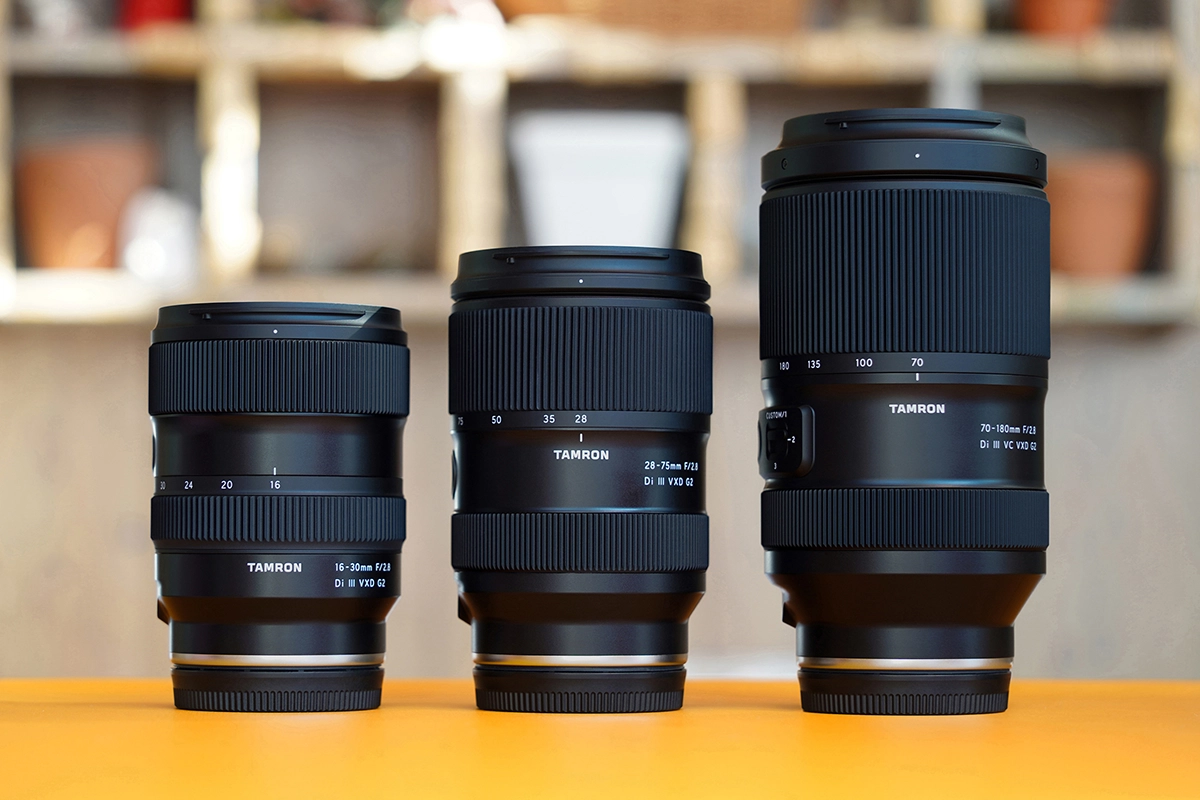A fast aperture lens is one of the most valuable tools a photographer can own—whether you shoot portraits, landscapes, low light, or creative shallow-depth-of-field images. In this guide, we’ll break down what a fast aperture lens is, why it matters, and highlight Tamron’s trio of F2.8 fast zoom lenses designed for Sony E-mount and Nikon Z-mount mirrorless cameras.
What You’ll Learn in This Post
- What the term fast aperture lens really means—and why “fast” has nothing to do with autofocus
- How aperture size affects light, depth-of-field, and image quality
- When and why to choose a fast aperture lens over a slower alternative
- The benefits of Tamron’s F2.8 fast zoom lineup for mirrorless systems
- How fast aperture lenses improve low-light performance and creative flexibility
What Is a Fast Aperture Lens?
A fast aperture lens features a wide maximum aperture—like F2.8 or wider—that allows more light to reach the camera sensor. The word fast refers to how quickly light enters the lens, enabling you to use faster shutter speeds.
How Aperture Works
-
A smaller f-number (e.g., F2.8) = larger opening = more light
-
A larger f-number (e.g., F4 or F5.6) = smaller opening = less light
The wider the aperture, the better the lens performs in low light and the greater your ability to blur backgrounds for creative depth-of-field.
Fast vs. Slow Lenses: What’s the Difference?
Below is a quick comparison of fast (F2.8) vs. slow (F4–5.6) lenses:
| Feature | Fast Aperture Lens (F2.8 or wider) | Slow Lens (F4–5.6) |
|---|---|---|
| Light Intake | High—great for low-light scenes | Lower—requires more light |
| Shutter Speeds | Faster speeds possible | Often slower, risk of blur |
| Depth-of-Field | Shallow, creamy bokeh | Deeper, more in focus |
| ISO Requirements | Lower ISO, cleaner images | Higher ISO often needed |
| Creative Flexibility | Excellent | Moderate |
| Size/Weight | Typically larger | Usually lighter |
Bottom line: A fast aperture lens expands your shooting options and improves image quality in challenging conditions.
How and When to Use a Fast Aperture Lens

1. Create Beautiful Background Blur
Shooting at F2.8 gives you striking subject separation—perfect for:
- Portraits
- Weddings
- Product photography
- Creative storytelling shots
2. Improve Low-Light Photography
Fast aperture lenses shine when the lights dim:
- Indoor events
- Evening city scenes
- Concerts
- Candlelit environments
- Astro and night photography
You can maintain cleaner images and minimize motion blur without pushing ISO to extremes.
Tamron Fast Aperture Zooms for Mirrorless Systems

Tamron offers a powerful G2 lineup of F2.8 fast aperture zooms for Sony E-mount and Nikon Z-mount:
16–30mm F2.8 G2 (Model A064)
Ideal for: Landscapes • Architecture • Travel • Night Sky Photography
Key Highlights:
- Ultra-wide F2.8 aperture for low-light and night-sky performance
- Updated optics for edge-to-edge sharpness
- Moisture-resistant construction
- Fluorine coating for easy cleaning
- Lightweight design ideal for on-the-go creators
A perfect lens for sweeping vistas and immersive compositions, the 16–30mm F2.8 G2 lets you shoot wide without sacrificing speed or clarity. Available for Sony E-mount and Nikon Z-mount.
28–75mm F2.8 G2 (Model A063)
Ideal for: Portraits • Lifestyle • Events • Travel
Key Highlights:
- Constant F2.8 aperture throughout the zoom range
- Outstanding portability and compact design
- Fast, accurate AF for stills and video
- Superb close-focusing capability
- Enhanced optical performance over the original version
The 28–75mm F2.8 G2 is Tamron’s bestselling standard zoom—small, fast, sharp, and incredibly versatile. Available for Sony E-mount and Nikon Z-mount.
70–180mm F2.8 G2 (Model A065)
Ideal for: Portraits • Sports • Wildlife • Events
Key Highlights:
- Bright F2.8 aperture across 70–180mm
- High-speed AF tracking for action shooting
- Precision optics delivering excellent contrast and clarity
- Moisture-resistant construction for outdoor performance
- Compact telephoto design that’s lighter than traditional 70–200mm lenses
Powerful, portable, and responsive, the 70–180mm F2.8 G2 gives you exceptional reach without the typical weight of telephoto glass.
Why Choose a Tamron Fast Aperture Lens?

Tamron’s G2 Trinity lineup delivers:
- Constant F2.8 brightness
- Professional-level optical performance
- Durable build quality
- Advanced autofocus systems
- Exceptional value compared to competing lenses
When you’re ready to upgrade your creative possibilities, Tamron fast aperture lenses give you the tools to produce truly standout images.
Ready to Explore a Fast Aperture Lens?
If you’re considering a fast aperture lens to expand your creative options, explore Tamron’s fast zoom lineup. Visit one of our authorized dealers or shop directly at the TAMRON Store to find the perfect fit.
FAQs About Fast Aperture Lenses
1. What does “fast lens” mean?
It refers to a lens with a large maximum aperture (like F2.8), allowing more light to enter so you can use faster shutter speeds.
2. Why is a fast aperture lens better in low light?
Because it lets in more light, allowing you to shoot clearer images with lower ISO and less noise.
3. Do I need a fast lens for portraits?
While not required, a fast F2.8 lens gives you beautifully blurred backgrounds and superior subject separation.
4. Are F2.8 lenses good for video?
Yes—fast lenses allow for consistent exposure across zoom ranges and smoother background separation, ideal for filmmaking.
5. Are fast lenses heavier?
Often yes, because wider apertures require larger glass elements—but Tamron’s G2 lineup is designed to be lightweight for its class.
6. Which Tamron fast zooms are available for Nikon Z-mount?
The 28–75mm F2.8 G2, 16–30mm F2.8 G2, and 70–180mm F2.8 G2 are available for both Sony E-mount and Nikon Z mount.
